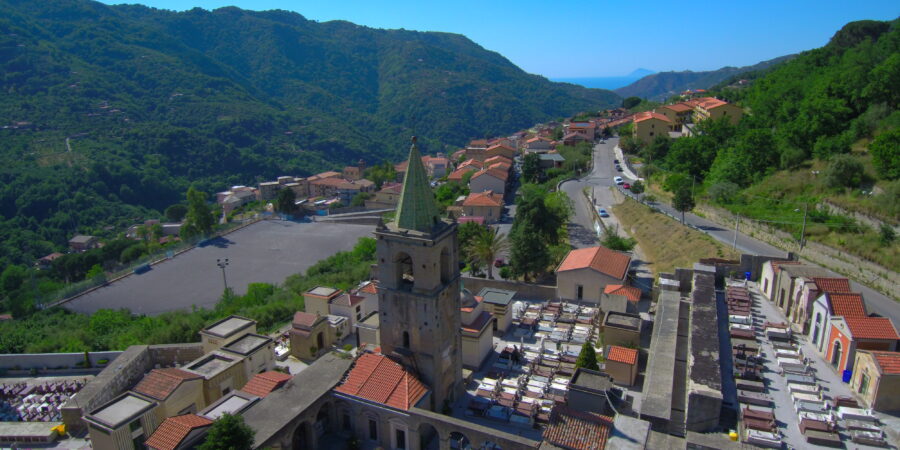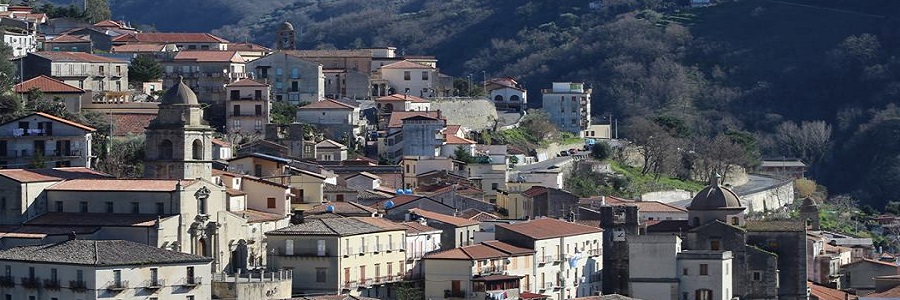Cimitero, ex Monastero Basiliano

🇮🇹 La fondazione dell’ex monastero basiliano coincide con la nascita di Sant’Angelo di Brolo.
L’origine di Sant’Angelo risale al XI Secolo, quando i normanni, guidati dal conte Ruggero d’Altavilla, liberarono l’intera valle dal dominio dei Saraceni, che la occupavano da più di due secoli. La tradizione popolare afferma che nella battaglia finale, Ruggero invocò l’aiuto dell’Altissimo, chiedendo di poter battere i suoi avversari prima che arrivasse la notte. L’invocazione fu esaudita: il sole sembrò fermarsi e apparve, in un grande splendore, l’immagine celestiale di S. Michele Arcangelo, auspice della vittoria normanna che sarebbe arrivata di lì a poco.
Nel punto in cui apparve il guerriero celeste venne costruita un’edicoletta che, nonostante numerosi restauri, permane ancora. Il conte Ruggero, in segno di riconoscenza verso S. Michele, ordinò l’edificazione di un grandioso convento con annessa chiesa e li affidò ai monaci basiliani; dispose, inoltre, che gli abitanti degli antichi borghi già esistenti durante l’invasione mussulmana, si riunissero in un unico centro a cui è stato dato il nome di Sant’ Angelo, in onore di S. Michele, divenuto patrono del paese.
Il primo abate fu Erasmo, eletto nel 1084, che divenne anche signore feudale del luogo.
Cessato il potere temporale degli abati basiliani sui santangiolesi, rimase al convento di San Michele il possesso di alcuni poderi, fino all’emanazione delle leggi del 1866/67, che sopprimevano tutti gli ordini religiosi.
La costruzione originaria del monastero, di cui oggi permangono pochi resti, si estendeva per una superficie di circa 3000 mq. Distrutto nel 1450, a causa di un violentissimo terremoto, fu riedificato per intero. Del complesso, destinato dal 1879 a cimitero, rimangono solo il chiostro, nelle cui arcate sono state collocate le cappelle gentilizie, e il campanile della chiesa con la guglia ottagonale, rivestita da piastrelle maiolicate (in parte rifatte ad imitazione delle antiche). Sulla cima della guglia si trova l’immagine di S. Michele, forgiata in lamiera di ferro. Vi sono anche resti della cinta muraria e dell’arco di ingresso alla chiesa a nord, su cui si legge la data 1556. A sud sono ancora visibili lo stipite e l’architrave di un portale di accesso al chiostro. Sono sparsi all’interno reperti di colonne, capitelli e fregi. La chiesa è crollata per incuria nel 1923.
Nella cripta sotto l’abside esiste ancora un pregevole affresco d’epoca, in ottimo stato di conservazione, effigiante il Crocifisso.
Lo spazio che un tempo era occupato dall’intero monastero basiliano è oggi adibito a cimitero comunale.
FONTI:
Nicola Fazio – Terra di S.Angelo (ed. Pungitopo)
Achille Caldarera – S.Angelo (Cenno Storico)
Daniele Tranchida – Sotto il Mantello dell’Abbazia
Basilio Segreto – Archivio Storico Santangiolese
🇬🇧 The foundation of the former Basilian monastery coincides with the birth of Sant’Angelo di Brolo.
The origin of Sant’Angelo goes back to the 11th century, when the Normans, led by Count Ruggero of Altavilla, set the entire village free from the dominion of the Saracens, who had been occupying the territory for over two centuries. Popular tradition tells that, when the final battle took place, Ruggero sought the help of the Almighty and prayed so that he could be victorious over his enemies before the night.
His request was granted and so, in a moment of great splendor when the sun seemed to stop, the heavenly image of St. Michael the Archangel suddenly appeared as a sign of the imminent victory of the Normans.
In the same place where the Archangel appeared, a small aedicule was built which, in spite of numerous restorations, still remains.
Count Ruggero, as a sign of gratitude towards St. Michael, ordered the construction of a magnificent convent with attached church and entrusted it to the Basilian monks. He then disposed that all citizens of the ancient villages that already existed when the Muslim invasion occurred would come to inhabit the same place which was later given the name of Sant’Angelo, in honor of St. Michael who was named its patron saint.
The first abbot was Erasmo, elected in 1084, who also became the feudal lord of the village.
With the temporal power of the Basilian monks being abolished the convent of St. Michael only kept a few farms but only until the issuing of the laws of 1866/67 with which all religious orders were suppressed.
The original construction of the monastery, of which only a few ruins remain today, stretched out over 3000 sqm. Destroyed in 1450, following a violent earthquake, the monastery was then completely rebuilt. What today remains of the original structure, which was used as a cemetery since 1879, is the cloister, in whose arches are located noble chapels, and the bell tower of the church ending in an octagonal spire covered with majolica tiles (partly an imitation of the ancient ones). On the top of the spire there is an image of S. Michael forged in iron sheet. There are also remains of the city walls and the entrance arch to the northern part of the church, carved with the date 1556. Additionally, south of the church, you can still admire the jamb and the architrave of the access portal to the cloister. Scattered among the remains are also some columns, capitals and friezes. The church collapsed from neglect in 1923.
In the crypt, under the apse, it can be found a very fine period fresco representing the Crucifix that’s been preserved in excellent condition.
The space that was once occupied by the entire Basilian monastery is nowadays used as a municipal cemetery.
Traduzione a cura di Maria Diletta Fazio, Francesca Cortolillo e Alessia Bertolone


